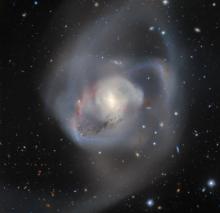Listen to today's episode of StarDate on the web the same day it airs in high-quality streaming audio without any extra ads or announcements. Choose a $8 one-month pass, or listen every day for a year for just $30.
You are here
Extreme Starbursts
On average, our home galaxy, the Milky Way, gives birth to only a few stars per year. But that’s a mere pittance compared to some galaxies. The most prolific churn out thousands of stars. At that rate, they could double their total number of stars in a few hundred million years.
Starburst galaxies don’t look that much brighter than more sedate galaxies like the Milky Way. But they shine much brighter in the infrared — the glow of warm clouds of dust around the newborn stars.
Such galaxies are quite massive. And they have huge amounts of gas — the raw material for stars. The Milky Way has already used up most of its gas, so it doesn’t have a lot left for making more stars.
Something squeezes big clouds of gas in starburst galaxies, causing them to collapse. The clouds then break apart into smaller clumps, which in turn collapse to form stars.
Extreme starburst galaxies are giving birth to a number of stars that’s equal to thousands of times the mass of the Sun every year. And one galaxy appears to be birthing as many as 30,000 solar masses of stars a year. Stars come in a wide variety of sizes, with most stars less massive than the Sun. So the actual number of stars could be even higher.
So far, astronomers aren’t quite sure what’s causing such pyrotechnics. Most models of how stars form can’t produce such impressive numbers. So theorists still have some work to do to explain these prolific galaxies.
Script by Damond Benningfield





